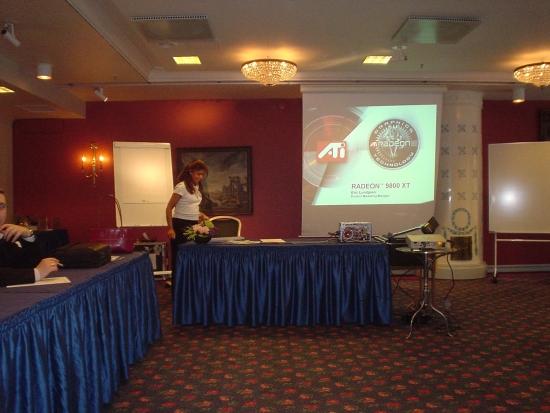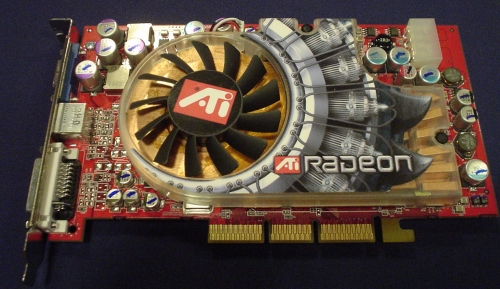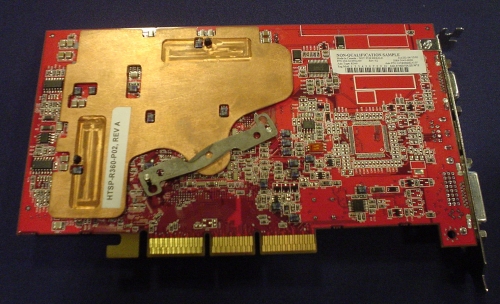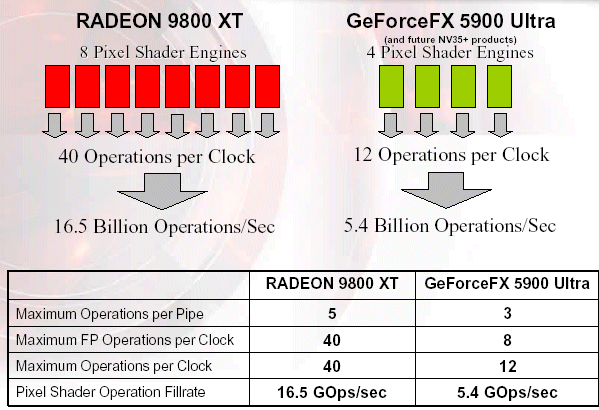It’s time for a new refresh from ATI. This time we take a peak at the new Radeon 9800XT.
Introduction
Its been more than a year now since ATI contacted me and invited me in for my first press event. At that time they had started to stir up the 3D video card arena by releasing the excellent Radeon 9700 Pro. Since then ATI has basically taken over the high-end (and some would argue are on the verge of taking over the mid-end to soon) segment with their Radeon 9800 and Radeon 9800 Pro cards. So whats next?
A couple of weeks ago I was invited to a press event here in Stockholm where I would get to see the next step in ATIs road to supremacy the Radeon 9800 XT and the Radeon 9600 XT.
 |
|
Rubeena Hussein from ATI preparing the pressevent. Notice the small ShuttleX SFF computer that they use with the new Radeon 9800XT.
|
The Radeon 9600 XT
The Radeon 9800XT
As you noticed the step between the Radeon 9600 Pro and Radeon 9600 XT was a small evolutionary step. The same could be said about the step between the Radeon 9800 Pro and the Radeon 9800 XT. This is the high-end card. Lots of memory, lots of performance and unfortunately a high price.
Lets take a look on what the Radeon 9800 XT can offer:
| Radeon 9800 | Radeon 9800 Pro 1280 MB | Radeon 9800 Pro 256 MB | Radeon 9800XT | |
| Core speed | 325 | 380 | 380 | 412 |
| Memory speed | 580 | 680 | 700 | 730 |
| Memory | 128 MB | 128 MB | 256 MB | 256 MB |
Once again we see an evolutionary step where the Radeon 9800XT is 4-8% faster when you look at clock speed and memory speed.
So except for the faster clock speeds, what is special with the XT?
Improved cooling
I can tell you that the card was heavy! Thats because 9800XT uses an improved copper based cooling solution that cools both the chip and the memory.
Compared to the high-end NVIDIA cards, the Radeon 9800XT still is a one-slot solution. What really impressed me was that during the presentation they did run the card inside a Shuttle XPC SFF (small form factor) computer with the stock power supply.
The fan also monitors the temperature and can change its speed accordingly.
 |
|
The front of the Radeon 9800XT – the fan covers both the GPU and the memory.
|
 |
| The back of the Radeon 9800XT. The copper makes this card heavy! |
Dynamic overclocking
This is an interesting feature. In a future Catalyst update, ATI will turn on the Overdrive functionality of the Radeon 9800XT, which will effectively make the chip overclock itself when it notices that the load on the chip has increased (ex. while you are playing a 3D game). NVIDIA has something similar as you can set up separate clockspeeds for 2D and 3D, but Overdrive seems to promise that the ASIC itself finds the best clockspeed at the moment depending on how warm the chip is, how hot it is in the case, etc.
It will be interesting to see how it works.
Shader performance
We all know by now that ATI is the king when it comes to shader performance. ATI continues to hammer In this fact. Just look at this slide:
 |
|
Ouch …..
|
Ouch NVIDIA. You better come up with something fast because we have started to see what this difference can do in games.
With the 9800XT, ATI has continued to improve the Real Time Shading effects including introducing the support for Überlight. Überlight must be seen as it is real cool. They showed a small demo of a statue that was being lit by spotlights and how the shadow behind wasnt uniform but varied and became more blurry in certain situations. Its hard to explain but it looked real good.
The recommended price for the Radeon 9800XT here in Europe will be 499 plus VAT.
Benchmark
I had the opportunity to use a Radeon 9800XT for 2 days to run some quick benchmarks.
My System:
| CPU | XP2500+ |
| Motherboard | MSI nForce2 |
| Memory | 1024 PX2700 DDR |
| GPU 1 | Radeon 9800 XT |
| GPU 2 | Radeon 9800 Pro 256 MB |
| GPU 3 | BFG FX5900 Ultra |
The drivers used for the NVIDA FX5900 Ultra were the 45.23 Detonators (the new 5x.xx Dets didn’t work for me), and for the Radeon cards I used Catalyst 3.7 drivers provided by ATI.
3DMark 2001 SE
|
|||||||||||||||||||||||||||
UT2k3 Antalus Botmatch
|
|||||||||||||||||||||||||||
UT2k3 Asbestos Botmatch
|
|||||||||||||||||||||||||||
Aquamark 3 – Vertex&Pixel Lightning
|
|||||||||||||||||||||||||||
Q2 AA should be the same as 4xAA. While the ATI cards only can use up to Q3 (which thus should be 6xAA) the NVIDIA FX5900 Ultra can use up to Quality 4 AA which should be the same as 8xAA.
Aquamark 3 – Vertex&Pixel Lightning
|
|||||||||||||||||||||||||||
Quality 3 AA should be the same as 6xAA on the ATI. I ‘think’ it is the same as 6XS AA on the FX5900 Ultra. Please bear that in mind when comparing the scores. Still, the FX5900 Ultra really gets creamed in the shader performance department when we increase the quality.
Aquamark 3 – Complex Multimaterial Shader
|
|||||||||||||||||||||||||||
Aquamark 3 – Complex Multimaterial Shader
|
|||||||||||||||||||||||||||
Aquamark 3 – Total Score
|
|||||||||||||||||||||||||||
Aquamark 3 – Total Score
|
|||||||||||||||||||||||||||
Half Life 2
Half Life 2 .. yes. Its true. Half Life 2 (or a voucher) will be bundled with all the XT ATI cards (or at least the ISVs will have the opportunity to bundle the game but who would be stupid enough not to?).
Conclusion
While there are improvements on both the Radeon 9600XT and the Radeon 9800XT, they werent exactly revolutionary products that we were shown. ATI still is building on the excellent foundation of the earlier cards, just improving a little with each refresh. Thats not a bad thing since the products they have right now are outstanding, but that also means that you need to think hard before upgrading if you already have a Radeon 9600 or a Radeon 9800.
 Bjorn3D.com Bjorn3d.com – Satisfying Your Daily Tech Cravings Since 1996
Bjorn3D.com Bjorn3d.com – Satisfying Your Daily Tech Cravings Since 1996



